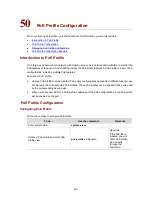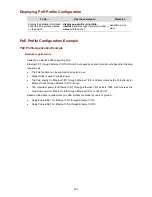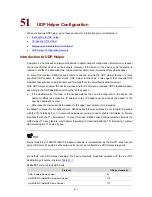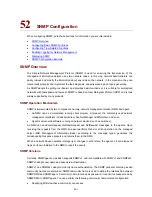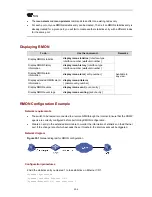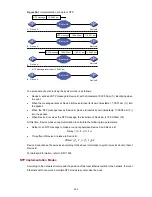
To do…
Use the command…
Remarks
Encrypt a plain-text password
to generate a cipher-text one
snmp-agent
calculate-password
plain-password
mode
{
md5
|
sha
} {
local-engineid |
specified-engineid engineid
}
Optional
This command is used if
password in cipher-text is
needed for adding a new user.
Add a user to an SNMP group
snmp-agent usm-user
v3
user-name
group-name
[ [
cipher
]
authentication-mode
{
md5
|
sha
}
auth-password
[
privacy-mode
des56
}
priv-password
] ] [
acl
acl-number
]
Required
Set the maximum size of an
SNMP packet for SNMP agent
to receive or send
snmp-agent packet max
-
size
byte
-
count
Optional
1,500 bytes by default.
Set the device engine ID
snmp-agent local
-
engineid
engineid
Optional
By default, the device engine ID
is “enterprise device
information”.
Create or update the view
information
snmp-agent mib
-
view
{
included
|
excluded
}
view
-
name
oid
-
tree
[
mask
mask-value
]
Optional
By default, the view name is
ViewDefault and OID is 1.
A Switch 4500 provides the following functions to prevent attacks through unused UDP ports.
z
Executing the
snmp-agent
command or any of the commands used to configure SNMP agent
enables the SNMP agent, and at the same opens UDP port 161 used by SNMP agents and the
UDP port used by SNMP trap respectively.
z
Executing the
undo snmp-agent
command disables the SNMP agent and closes UDP ports used
by SNMP agent and SNMP trap as well.
Configuring Trap-Related Functions
Configuring Basic Trap Functions
traps refer to those sent by managed devices to the NMS without request. They are used to report some
urgent and important events (for example, the rebooting of managed devices).
Note that basic SNMP configuration is performed before you configure basic trap function.
Follow these steps to configure basic trap function:
To do…
Use the command…
Remarks
Enter system view
system-view
—
52-4




